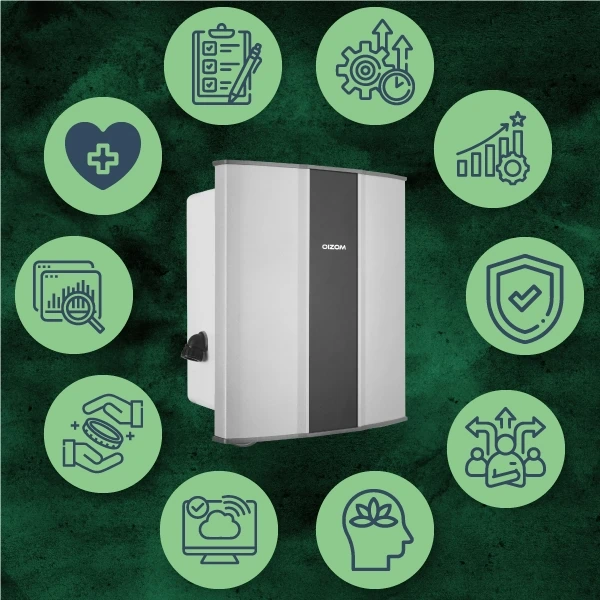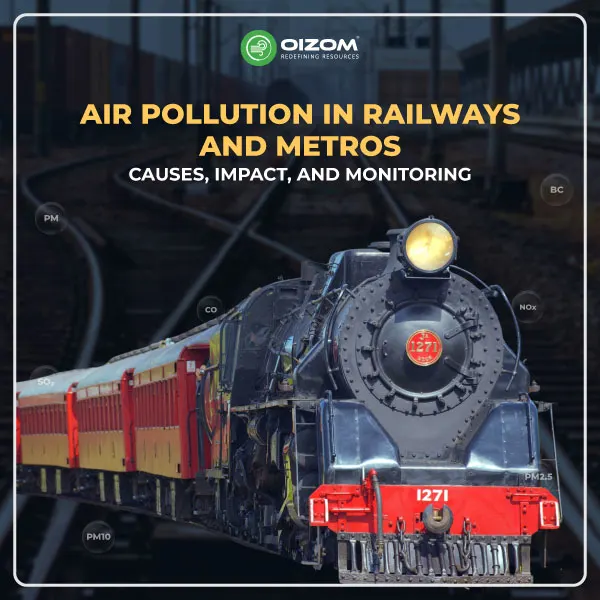In an era where environmental concerns are gaining paramount importance, the subject of toxic gases in our atmosphere is becoming increasingly significant. From the smog-laden cities of Beijing and London to the pristine suburbs, we are unwittingly inhaling pollutants detrimental to our health and the planet.
With advancements in environmental and tech industries, monitoring and mitigating these pollutants is becoming achievable. This comprehensive guide discusses the array of toxic gases, their origins, health implications, and the ways to curb their influence on our lives.
What Are Toxic Air Pollutants?
Toxic or hazardous air pollutants are chemicals in the air that pose significant risks to human health and the environment. They can originate from natural phenomena such as wildfires and volcanic eruptions or from anthropogenic sources, including industrial processes, vehicle emissions, and fuel combustion.
These pollutants can cause various health issues, from minor respiratory irritations to severe diseases like cancer, birth defects, and other long-term health problems.
Furthermore, when they linger in the environment, they can harm wildlife, water sources, and the soil. Understanding the various types of these pollutants and their effects is essential for addressing their underlying challenges.
Types of Toxic Gases
Hydrogen Sulfide (H2S)
Hydrogen sulfide is a colourless, flammable gas known for its pungent odour reminiscent of rotten eggs. It occurs naturally in crude petroleum, natural gas, volcanic gases, and hot springs. Additionally, microbial breakdown of organic materials in the absence of oxygen, as seen in swamps, sewers, and sewage treatment plants, produces this gas.
Impact: Low concentrations can cause eye irritation and a sore throat. Chronic exposure to higher concentrations can lead to fatigue, loss of appetite, headaches, irritability, poor memory, and dizziness. Extremely high concentrations can be instantly fatal.
Sources: Apart from natural sources, major contributors include sewage treatment plants, pulp and paper factories, and certain agricultural processes, especially where manure is stored.
Carbon Monoxide (CO)
Carbon monoxide is an extremely hazardous colourless, odourless, and tasteless gas. Its danger lies in its ability to bind to the haemoglobin in red blood cells, hindering the transport of oxygen around the body.
Impact: Inhalation can lead to symptoms ranging from mild headache and dizziness to severe cardiac complications and death, depending on concentration and exposure duration. Because it’s undetectable to human senses, people often don’t realise they’re being exposed until they experience symptoms or it’s too late.
Sources: CO emissions are predominantly a result of incomplete combustion. Cars, trucks, industrial processes, and even residential heaters and stoves can release significant amounts of carbon monoxide.
Nitrogen Oxides (NO)
Nitrogen oxides (NOx) refer to a group of highly reactive gases containing nitrogen and oxygen. These gases form when fuel is burned at high temperatures, as in an engine or furnace.
Impact: Health effects of NOx gases include inflammation of the airways and worsened bronchitis. They also play a major role in atmospheric reactions that produce ground-level ozone, another harmful air pollutant.
Sources: Motor vehicles are primary contributors. However, electric utilities, industrial boilers, and other fuel combustion sources also release NOx emissions.
Ozone (O3)
Ozone is a powerful oxidant. While high-altitude ozone protects us from the sun’s ultraviolet rays, ground-level ozone can be harmful.
Impact: Breathing ozone can trigger various health problems, particularly in children, elderly individuals, and those with lung diseases. It can cause chest pain, coughing, throat irritation, and congestion. Over time, regular exposure can reduce lung function and the ability to breathe deeply.
Sources: Ground-level ozone isn’t emitted directly. Instead, it forms in the atmosphere through a chemical reaction between NOx and volatile organic compounds (VOC) in the presence of sunlight. Major emitters include industrial facilities, motor vehicles, petrol vapours, and chemical solvents.
VOCs
Volatile Organic Compounds (VOCs) represent a collection of organic chemicals with high vapour pressure at room temperature, allowing them to evaporate or sublimate into the surrounding air easily. These compounds consist of various elements, primarily carbon and hydrogen, oxygen, fluorine, chlorine, bromine, sulfur, or nitrogen. VOCs are prolific and can be detected in both indoor and outdoor environments, originating from diverse sources. They play a significant role in atmospheric chemistry and are known to be hazardous pollutants. Some common examples of VOCs include formaldehyde, benzene, and acetone.
Impacts: When inhaled, VOCs can cause immediate and long-term health effects, ranging from headaches and dizziness to liver and kidney damage, and can even lead to certain forms of cancer. VOCs can also react with nitrogen oxides in the presence of sunlight to form ground-level ozone, a key component of smog, affecting air quality and posing respiratory risks to humans and animals alike. Additionally, they contribute to the formation of secondary organic aerosols, which have implications for climate change, influencing both weather and atmospheric conditions.
Sources: In nature, VOCs are released from plants, primarily as a defence mechanism or as a byproduct of metabolic processes. Human-related sources include vehicle exhausts, industrial emissions, fuel combustion, and products like paints, solvents, and cleaning agents. Household products, building materials, and furnishings can also emit VOCs, impacting indoor air quality significantly and posing additional exposure risks to inhabitants.
Where Do The Toxic Air Pollutants Come From?
Toxic air pollutants emanate from a diverse array of sources. Natural events such as volcanic eruptions, forest fires, and dust storms release certain hazardous compounds into the atmosphere.
However, human activities are the dominant contributors. Industrial processes, for instance, discharge pollutants in the form of emissions from factories, power plants, and refineries. Transport plays a significant role, too, with car exhausts, ship emissions, and aviation contributing massive amounts of pollutants, including nitrogen oxides and carbon monoxide.
Agricultural activities introduce methane from livestock and particulate matter from tilling and ploughing. Even households contribute by burning solid fuels, using chemical solvents and aerosol sprays, and releasing pollutants indoors and out. Urbanisation and deforestation further exacerbate the issue by altering natural processes that would otherwise help mitigate some of the pollution.
What Are the Health Effects of Toxic Air Pollutants?
Toxic air pollutants have profound health implications. Short-term exposure can lead to respiratory distress, irritation of the eyes, nose, and throat, and exacerbation of chronic respiratory diseases like asthma. Long-term exposure is even more concerning. Prolonged inhalation of polluted air increases the risk of developing cardiovascular and respiratory diseases.
Carcinogenic pollutants such as benzene or formaldehyde can raise the risk of cancers, particularly lung cancer. Vulnerable groups, including children, the elderly, and those with pre-existing health conditions, face heightened risks. Exposure during developmental phases can lead to lifelong respiratory conditions and diminished lung function for children.
Moreover, recent studies suggest a link between air pollution and neurological conditions, including cognitive decline and mental health disorders. The cumulative effect of these pollutants underscores the urgent need for addressing air quality issues to safeguard public health.
Tips to Avoid Toxic Gases Exposure
In today’s rapidly urbanising world, exposure to toxic gases is, unfortunately, an ever-present concern. However, with a few proactive steps, individuals can significantly reduce their risk:
- Ventilation is Key: Regularly airing out your home or workspace can dispel any build-up of harmful gases, especially in areas where chemicals or fuels are often used.
- Limit Outdoor Activities During High Pollution Days: Urban centres provide daily air quality indices. When pollution levels are high, it’s advisable to stay indoors, especially during peak traffic hours.
- Choose Green Vehicles: Opting for electric or hybrid vehicles reduces the emission of harmful gases. Also, regular maintenance of older vehicles can help limit their pollutant output.
- Household Awareness: Many cleaning agents, paints, and solvents release toxic gases. Always use these in well-ventilated areas and consider switching to natural or organic alternatives.
Protective Gear: In areas where toxic gas exposure is likely, using masks and respirators can be a lifesaver.
Solutions and the Role of Oizom in Mitigating Toxic Gases
The threat of toxic gases isn’t just a personal issue; it’s a global challenge requiring innovative solutions. Addressing the root of the problem involves several strategies:
- Clean Energy Transition: Shifting from fossil fuels to renewable sources like solar and wind energy can dramatically reduce the release of toxic gases. Such a transition benefits the environment and creates sustainable economic growth.
- Robust Public Transport: Developing and promoting efficient public transport systems can reduce vehicle emissions, a significant source of air pollutants.
- Regulations and Standards: Governments should enforce stringent emission standards for industries and vehicles. Regular checks and penalties can ensure compliance.
- Public Awareness: Educating the public about the sources and effects of toxic gases is vital. When informed, communities can make better choices and advocate for cleaner practices.
This is where Oizom steps in, offering an invaluable tool in the fight against toxic gas exposure. Oizom’s air quality monitors are designed to detect many pollutants, including many toxic gases. By providing real-time data, these monitors allow individuals, communities, and authorities to make informed decisions about outdoor activities, implement timely interventions, and assess the effectiveness of anti-pollution measures.
Additionally, industries can use Oizom’s solutions to monitor and control their emissions, ensuring they remain within safe and permissible limits. This not only safeguards the environment but also protects workers from hazardous exposure.
For urban planners and policymakers, the data from Oizom’s devices can guide city planning, helping to design greener, more breathable urban spaces. In essence, with tools like those provided by Oizom, society is better equipped to face the challenges of toxic gases, ensuring cleaner air for all.
FAQs
Toxic air pollutants originate from various sources, such as industrial emissions, vehicle exhaust, and burning fossil fuels and waste. These pollutants can also be formed through chemical reactions in the atmosphere involving gases released by human activities and natural processes.
Exposure to toxic air pollutants can lead to severe health conditions, including respiratory issues, cardiovascular diseases, and neurological damage. Long-term exposure may increase the risk of developing cancer and adversely affect reproductive, developmental, and immune systems.
Oxygen is the essential gas for respiration. It is inhaled by organisms and used to produce energy through the process of cellular respiration, where it reacts with glucose to release energy, water, and carbon dioxide.
Nitrogen is the major air component, constituting around 78% of the Earth’s atmosphere by volume. It is a colourless, odourless, and tasteless gas that is relatively inert and plays a crucial role in various biological and industrial processes.
Nitrogen is more prevalent in the atmosphere, making up approximately 78% of the atmospheric composition, followed by oxygen at around 21%. The remaining 1% contains argon and other trace gases such as carbon dioxide, neon, and helium.
The duration chloramine gas stays in the air can vary based on environmental conditions like wind, temperature, and humidity, but it generally dissipates rapidly. Ensuring adequate ventilation when releasing chloramine gas is essential to minimise its presence and impact.
It is crucial to avoid exposure to numerous toxic gases, including carbon monoxide, chlorine, ammonia, sulfur dioxide, and nitrogen dioxide. These gases can pose serious health risks, leading to respiratory problems, organ damage, or even death, depending on the concentration and duration of exposure.






